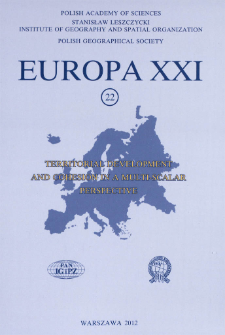
Obiekt
Tytuł: Cohesion and Development in the EU: A Multi-level Issue (Editorial)
Inny tytuł:
Wydawca:
Miejsce wydania:
Opis:
Typ obiektu:
Bibliografia:
1. Adams N., Cotella G., Nunes R. (Eds.), 2011, Territorial Development, Cohesion and Spatial Planning:Knowledge an policy development in an enlarged EU, London: Routledge.
2. Barca F., 2009, An Agenda For A Reformed Cohesion Policy. A place-based approach to meetingEuropean Union challenges and expectations. Independent Report prepared at the request ofDanuta Hübner, Commissioner for Regional Policy. Brussels: DG-Regio.
3. CEC – Commission of the European Communities, 1999, ESDP – European Spatial DevelopmentPerspective. Towards Balanced and Sustainable Development of the Territory of the EU, approvedby the Ministers responsible for Regional/Spatial Planning of the European Union. Luxembourg:European Communities.
4. CEC – Commission of the European Communities, 2008, Green Paper on Territorial Cohesion.Turning territorial diversity into strength, COM(2008) 616 final, 6 October, Brussels.
5. Cotella G., Adams N., Nunes R.J., 2012, Engaging in European Spatial Planning: A Central andEastern European Perspective on the Territorial Cohesion Debate, European Planning Studies
http://dx.doi.org/10.1080/09654313.2012.673567 [CrossRef]
6. DE Presidency, 2007, Territorial Agenda of the European Union: Towards a more competitiveand sustainable Europe of diverse regions, available at http://www.eu-territorial-agenda.eu/Reference%20Documents/Territorial-Agenda-of-the-European-Union-Agreed-on-25-May-2007.pdf (accessed July 2012).
7. Evers D., Tennekes J., Borsboom J., 2009, A Territorial Impact Assessment of Territorial Cohesion forthe Netherlands, The Hague: Netherlands Environmental Assessment Agency (PBL).
8. Faludi A. (ed.), 2007, Territorial Cohesion and the European Model of Society, Cambridge (MA):Lincoln Institute of Land Policy, pp. 23-35.
9. Faludi A., 2011, Cohesion, Coherence, Cooperation: European spatial planning coming of age?London: Routledge.
10. Faludi A., 2012, Multi-Level (Territorial) Governance: Three Criticisms , Planning Theory & Practice,13:2, 197-211
http://dx.doi.org/10.1080/14649357.2012.677578 [CrossRef]
11. Hooghe L., Marks G., 2001, Multilevel Governance and European Integration, Lanham, MD/Oxford,Rowman & Littlefield.
12. Hooghe L., Marks G., 2003, Unravelling the central state, but how? Types of multilevel governance,American Political Science Review, 97(2), 233–243.
13. Hooghe L., Marks G., 2010, Types of multi-level governance, in: H. Enderlein, S.Wa¨ lti &M. Zu¨ rn(Eds.) Types of Multilevel Governance, 17–31.
14. HU Presidency, 2011, Territorial Agenda of the European Union 2020: Towards an Inclusive, Smartand Sustainable Europe of Diverse Regions, available at http://www.eu2011.hu/files/bveu/documents/TA2020.pdf (accessed July 2012).
15. OECD, 2001, OECD Territorial Outlook, Paris: OECD Publication Services.
16. Sapir A., Aghion P., Bertola G., Hellwig M., Pisani-Ferry J., Rosati D., Viñals J., Wallace H., 2003,AN AGENDA FOR A GROWING EUROPE. Making the EU Economic System Deliver. Reportof an Independent High-Level Study Group established on the initiative of the President of theEuropean Commission.
17. Treaty of Lisbon, 2007, Treaty of Lisbon, Official Journal of the European Union, C 306/01. Availableat http://eur-lex.europa.eu/en/treaties/index.htm (accessed March 2011).
18. VÁTI, 2009, Handbook on territorial cohesion; Application of territorial approaches in developmentssupported by the public sector, Budapest: Ministry for National Development andEconomy/VÁTI.
19. Waterhout B., 2007, Territorial cohesion: the underlying discourses, in: Faludi, A. (ed.) TerritorialCohesion and the European Model of Society, Cambridge (MA): Lincoln Institute of Land Policy,37-59.
20. Waterhout B., 2008, The Institutionalisation of European Spatial Planning. Amsterdam: IOS Press.
21. Zonneveld W., Waterhout B., 2005, Visions on territorial cohesion. Town Planning Review76(1):15–27.
http://dx.doi.org/10.3828/tpr.76.1.2 [CrossRef]
22. Zonneveld W., Waterhout B., 2010, Implications of territorial cohesion: An essay, Paper preparedfor the Regional Studies Association Annual International Conference ‘Regional Responses andGlobal Shifts: Actors, Institutions and Organisations’, 24th - 26th May, Pécs, Hungary.
Czasopismo/Seria/cykl:
Tom:
Strona pocz.:
Strona końc.:
Szczegółowy typ zasobu:
Format:
Rozmiar pliku 0,5 MB ; application/pdf
Identyfikator zasobu:
oai:rcin.org.pl:31080 ; 1429-7132
Źródło:
CBGiOŚ. IGiPZ PAN, sygn.: Cz.6406, Cz.6407 ; kliknij tutaj, żeby przejść
Język:
Prawa:
Prawa zastrzeżone - dostęp nieograniczony
Zasady wykorzystania:
Digitalizacja:
Instytut Geografii i Przestrzennego Zagospodarowania Polskiej Akademii Nauk
Lokalizacja oryginału:
Dofinansowane ze środków:
Unia Europejska. Europejski Fundusz Rozwoju Regionalnego ; Program Operacyjny Innowacyjna Gospodarka, lata 2010-2014, Priorytet 2. Infrastruktura strefy B + R
Dostęp:
Kolekcje, do których przypisany jest obiekt:
- Repozytorium Cyfrowe Instytutów Naukowych > Kolekcje Partnerów > Instytut Geografii i Przestrzennego Zagospodarowania PAN > Publikacje pracowników i Wydawnictw
- Repozytorium Cyfrowe Instytutów Naukowych > Kolekcje Partnerów > Instytut Geografii i Przestrzennego Zagospodarowania PAN > Biblioteka Instytutu > Serie/Czasopisma/Cykle
- Repozytorium Cyfrowe Instytutów Naukowych > Piśmiennictwo > Czasopisma/Artykuły
Data ostatniej modyfikacji:
2 paź 2020
Data dodania obiektu:
15 lip 2013
Liczba pobrań / odtworzeń:
926
Wszystkie dostępne wersje tego obiektu:
https://www.rcin.org.pl/publication/50252
Wyświetl opis w formacie RDF:
Wyświetl opis w formacie RDFa:
Wyświetl opis w formacie OAI-PMH:
| Nazwa wydania | Data |
|---|---|
| Cotella G. - Cohesion and Development in the EU: A Multi-level Issue (Editorial) | 2 paź 2020 |
Obiekty Podobne
Cotella, Giancarlo
Epasto, Simona
Cotella, Giancarlo
Perger, Éva
Lepesant, Gilles
Cotella, Giancarlo

 INSTYTUT ARCHEOLOGII I ETNOLOGII POLSKIEJ AKADEMII NAUK
INSTYTUT ARCHEOLOGII I ETNOLOGII POLSKIEJ AKADEMII NAUK
 INSTYTUT BADAŃ LITERACKICH POLSKIEJ AKADEMII NAUK
INSTYTUT BADAŃ LITERACKICH POLSKIEJ AKADEMII NAUK
 INSTYTUT BADAWCZY LEŚNICTWA
INSTYTUT BADAWCZY LEŚNICTWA
 INSTYTUT BIOLOGII DOŚWIADCZALNEJ IM. MARCELEGO NENCKIEGO POLSKIEJ AKADEMII NAUK
INSTYTUT BIOLOGII DOŚWIADCZALNEJ IM. MARCELEGO NENCKIEGO POLSKIEJ AKADEMII NAUK
 INSTYTUT BIOLOGII SSAKÓW POLSKIEJ AKADEMII NAUK
INSTYTUT BIOLOGII SSAKÓW POLSKIEJ AKADEMII NAUK
 INSTYTUT CHEMII FIZYCZNEJ PAN
INSTYTUT CHEMII FIZYCZNEJ PAN
 INSTYTUT CHEMII ORGANICZNEJ PAN
INSTYTUT CHEMII ORGANICZNEJ PAN
 INSTYTUT FILOZOFII I SOCJOLOGII PAN
INSTYTUT FILOZOFII I SOCJOLOGII PAN
 INSTYTUT GEOGRAFII I PRZESTRZENNEGO ZAGOSPODAROWANIA PAN
INSTYTUT GEOGRAFII I PRZESTRZENNEGO ZAGOSPODAROWANIA PAN
 INSTYTUT HISTORII im. TADEUSZA MANTEUFFLA POLSKIEJ AKADEMII NAUK
INSTYTUT HISTORII im. TADEUSZA MANTEUFFLA POLSKIEJ AKADEMII NAUK
 INSTYTUT JĘZYKA POLSKIEGO POLSKIEJ AKADEMII NAUK
INSTYTUT JĘZYKA POLSKIEGO POLSKIEJ AKADEMII NAUK
 INSTYTUT MATEMATYCZNY PAN
INSTYTUT MATEMATYCZNY PAN
 INSTYTUT MEDYCYNY DOŚWIADCZALNEJ I KLINICZNEJ IM.MIROSŁAWA MOSSAKOWSKIEGO POLSKIEJ AKADEMII NAUK
INSTYTUT MEDYCYNY DOŚWIADCZALNEJ I KLINICZNEJ IM.MIROSŁAWA MOSSAKOWSKIEGO POLSKIEJ AKADEMII NAUK
 INSTYTUT PODSTAWOWYCH PROBLEMÓW TECHNIKI PAN
INSTYTUT PODSTAWOWYCH PROBLEMÓW TECHNIKI PAN
 INSTYTUT SLAWISTYKI PAN
INSTYTUT SLAWISTYKI PAN
 SIEĆ BADAWCZA ŁUKASIEWICZ - INSTYTUT TECHNOLOGII MATERIAŁÓW ELEKTRONICZNYCH
SIEĆ BADAWCZA ŁUKASIEWICZ - INSTYTUT TECHNOLOGII MATERIAŁÓW ELEKTRONICZNYCH
 MUZEUM I INSTYTUT ZOOLOGII POLSKIEJ AKADEMII NAUK
MUZEUM I INSTYTUT ZOOLOGII POLSKIEJ AKADEMII NAUK
 INSTYTUT BADAŃ SYSTEMOWYCH PAN
INSTYTUT BADAŃ SYSTEMOWYCH PAN
 INSTYTUT BOTANIKI IM. WŁADYSŁAWA SZAFERA POLSKIEJ AKADEMII NAUK
INSTYTUT BOTANIKI IM. WŁADYSŁAWA SZAFERA POLSKIEJ AKADEMII NAUK


































